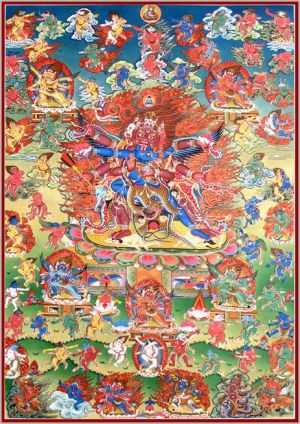Chemchok Heruka
Chemchok Heruka (Skt. Mahottara Heruka; Tib. ཆེ་མཆོག་, ཆེ་མཆོག་ཧེ་རུ་ཀ་, Wyl. che mchog he ru ka) — the main deity in the mandala of the fifty-eight wrathful deities (the wrathful aspect of Samantabhadra). Chemchok Heruka is also the central deity in the mandala of Tsokchen Düpa and Kagyé.
Chemchok Heruka has twenty-one heads and forty-two hands. The two principal hands hold Samantabhadra and Samantabhadri. His twenty hands on the right side hold the five buddhas of the five families, the eight bodhisattvas, the four male gatekeepers as well as three of the six munis – those who emanate in the three higher realms.
And the twenty left hands hold the five buddha consorts, the eight female bodhisattvas, the four female gatekeepers and the three munis who emanate in the three lower realms. The deities in the right hands are all male and the deities in the left hands, with the exception of the three munis, are all female. These forty-two deities are the peaceful deities of the mandala of the hundred peaceful and wrathful deities.
The consort of Chemchok is Namshyalma (Tib. གནམ་ཞལ་མ་, Wyl. gnam zhal ma). She has nine heads and eighteen hands. Her main central hands hold a vajra and skull-cup (Skt. kapala). The eight hands on her right hold the wrathful manifestations of the eight bodhisattvas, known as the eight gaurima and then the eight on the left hold the wrathful emanations of the eight female bodhisattvas known as the eight singhama.
External Links
Source
Chemchok Heruka (che mchog he ru ka).
Most Supreme (che mchog). Chemchok Heruka. Usually identical with Nectar Quality, the chief heruka of the ratna family. Sometimes, in the case of Assemblage of Sugatas, the Most Supreme is the heruka who embodies all the buddha families.
